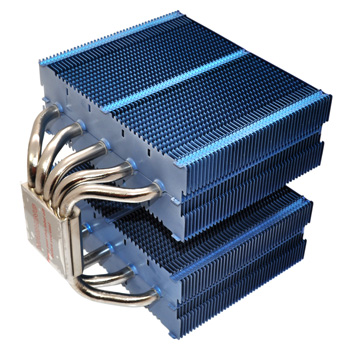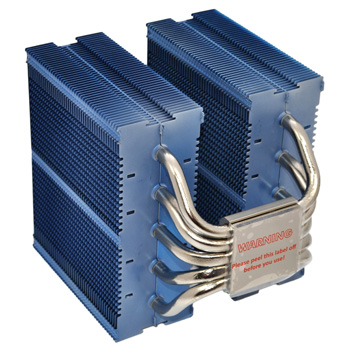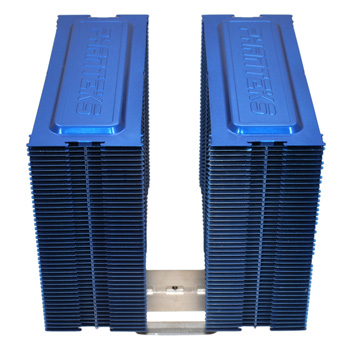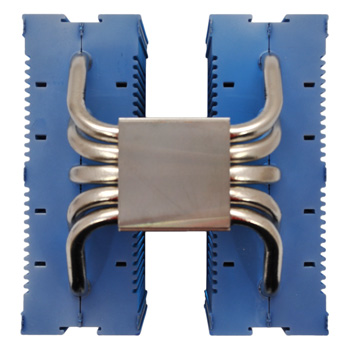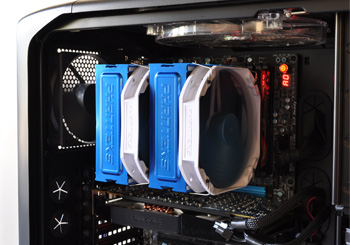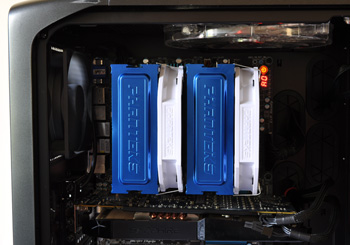A Closer Look
Dual-tower heatsinks aren't entirely new - dare we say it, the PH-TC14PE has a lot in common with Noctua's popular NH-D14 - but Phanteks is bringing some new tricks to the table.
According to the marketing blurb, the heatsinks feature a patented Physical Antioxidant Thermal Shield (P.A.T.S) that's said to "greatly increase cooling performance and reliability while deflecting thermal radiation from other heat sources." And, on top of that, there's a patented layer of Cold Plasma Spraying Coating (C.P.S.C) technology that's supposed to make the fins more efficient at dissipating heat.
All sounds a bit hocus pocus to us, but we'll let the cooler's performance speak for itself a littler later in the review.
Marketing acronyms aside, we do like the look of Phanteks's design. The PH-TC14PE feels well built and carefully finished, with each of the 88 serrated fins perfectly aligned and capped with a sleek aluminium lid emblazoned with the Phanteks logo.
There's just enough room between each radiator for the 25mm-thick fan to fit in without too much difficulty, and the top of the baseplate is thoughtfully tweaked to help aid installation, too. In addition to the grooves that allow the installation bridge to slot into place, there's a hole that enables the bridge to be screwed in securely.
Underneath the radiators, we get a look at the five 8mm-thick copper heatpipes that are soldered to the nickel-plated copper baseplate. The contact plate is close to being perfectly flat, but it isn't polished to a gleaming mirror finish and a few machining marks are visible. On the whole, build quality is very good, but a cooler of this size does present a few problems during installation.
It all starts off easy enough; the backplate and mounting brackets are practically identical to what's on offer from many other high-end solutions, and getting them in place on an LGA 1155 socket is simple and straightforward. However, things get complicated when you attach the heatsink, as the radiator will cover the first memory slot on most motherboards. We had to remove the extended heatspreader on our G.Skill memory in order to get it in place, and, of course, with the fan attached, the PH-TC14PE is going to cover just about all of the memory slots and rule out high-profile memory as a compatible option.
But let's be honest, a cooler of this size was always going to bring memory restrictions into play. What's important is that the cooler isn't too difficult to install. With the mounting bridge attached to the baseplate, installing the heatsink onto the mounting brackets is a case of fastening two screws. Though, considering the price, it's a shame Phanteks doesn't include a long-handled screwdriver in the bundle.
Attaching the fans is where things get a bit more fiddly. Phanteks uses small fan clip adapters that need to be inserted into each fan, and though they ultimately work well, getting the metal clips to feed through can be tricky. Remember, as a result of the central mounting bridge, it isn't possible to install the middle fan prior to mounting the heatsink.
The PH-TC14PE certainly looks the business when it's up and running, and if you are desperate for that last ounce of performance, it's easy to add an optional third fan - though, it would be mighty close to the rear exhaust fan on most chassis.
Performance testing starts just over the page, but before we get to that let's rate the PH-TC14PE on presentation, installation and aesthetics. Each category is scored out of five and we provide an overall percentage, too.
Presentation |
Installation |
Aesthetics |
 |
 |
 |
 |
The Phanteks PH-TC14PE cooler could be better presented, we feel, but a relatively-easy install and plenty of aesthetic appeal make for a good overall score of 73 per cent.






